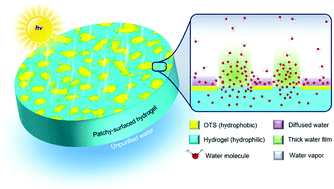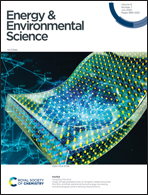Tailoring surface wetting states for ultrafast solar-driven water evaporation†
Abstract
Solar-driven interfacial evaporation has significant potential to improve the energy utilization efficiency and provides a means for sustainable seawater desalination and water purification technologies. Although rational design of evaporative materials and surfaces is essential to the interfacial solar water vaporization process, tailoring the surface wettability states of solar evaporators to accelerate the vapor generation rate remains unexplored. Here we demonstrate hydrophilic hydrogel evaporators with hydrophobic island-shaped patches, capable of achieving a record evaporation rate of ∼4.0 kg m−2 h−1 with 93% efficiency under 1 sun irradiation (1 kW m−2). This exceptional high rate results from both wetting regions, which function synergistically. The increased thickness of the water layer in the hydrophilic region leads to the rapid escape of water molecules, while relatively long contact lines promise considerable water evaporation from the hydrophobic region, further contributing to this process. Molecular dynamics simulations provide a consistent outcome on a molecular basis, in which an inhomogeneous surface wetting property could modulate the escape behavior of water molecules to speed the evaporation. Under natural sunlight, a 3D printed portable solar water purification jug using this hydrogel evaporator delivers purified water far above the EPA drinking water standards, highlighting its potential for water purification.

- This article is part of the themed collection: Energy & Environmental Science Cover Art


 Please wait while we load your content...
Please wait while we load your content...